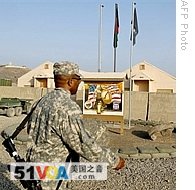Washington
05 February 2009
 |
| A US soldiers walks through compound at Forward Operating Base Salerno on outskirts of Khost, Afghanistan (file) |
In classic strategy making, planners identify their goals and the associated risks, before deciding how to proceed. But as the Obama Administration continues to develop its official strategy for Afghanistan, the president is expected to go ahead and approve additional troop deployments.
Pentagon Press Secretary Geoff Morrell explains why. "No matter what your overall strategy may be, we need to reverse the trends that we are seeing in some parts of the country in terms of a deteriorating security situation. That is accepted as the foundation on whatever the president decides to develop in terms of a further strategy," he said.
Morrell says whatever the details, the United States will continue to pursue a military and civilian counterinsurgency strategy in Afghanistan, combining military action against insurgents with support for the local government and economic development efforts.
Defense Secretary Robert Gates says he advocates some changes in the specific strategic goals he helped pursue during the Bush Administration. "One of the points where I suspect both administrations come to the same conclusion is that the goals we did have for Afghanistan are too broad and too far into the future, are too future-oriented, and that we need more concrete goals that can be achieved realistically within three to five years in terms of reestablishing control in certain areas, providing security for the population, going after al Qaeda, preventing the reestablishment of terrorism, better performance in terms of delivery of services to the people, some very concrete things," he said.
Secretary Gates says if the United States and its allies try to create what he called a "Central Asian Valhalla," or paradise, they will fail. That apparently refers to such goals as the establishment of a western-style democracy, free economy, human rights to western standards and many other society-building goals of the Bush Administration.
But Gates says the United States does have one very important goal in Afghanistan that it must achieve. "While this will undoubtedly be a long and difficult fight, we can attain what I believe should be among our strategic objectives: an Afghan people who do not provide a safe haven for Al Qaeda, reject the rule of the Taliban, and support the legitimate government that they elected and in which they have a stake," he said.
Secretary Gates supports the expected Afghanistan troop buildup, but he has also warned against sending too many U.S. troops to Afghanistan, and creating the impression that the troops are an occupying force.
Still, U.S. military commanders and civilian officials believe even limited goals in Afghanistan will require more troops, and they also note that it takes time to deploy the troops once the decision is made.
One additional brigade of 3,500 U.S. troops has just arrived in Afghanistan. If the president decides now to send more, they are not expected to arrive for several months, just as the summer fighting season is getting into full swing. And the U.S. commander in Afghanistan, General David McKiernan, wants still more by the end of the year, nearly doubling the U.S. troop total to about 60,000, plus NATO forces and a larger Afghan army.